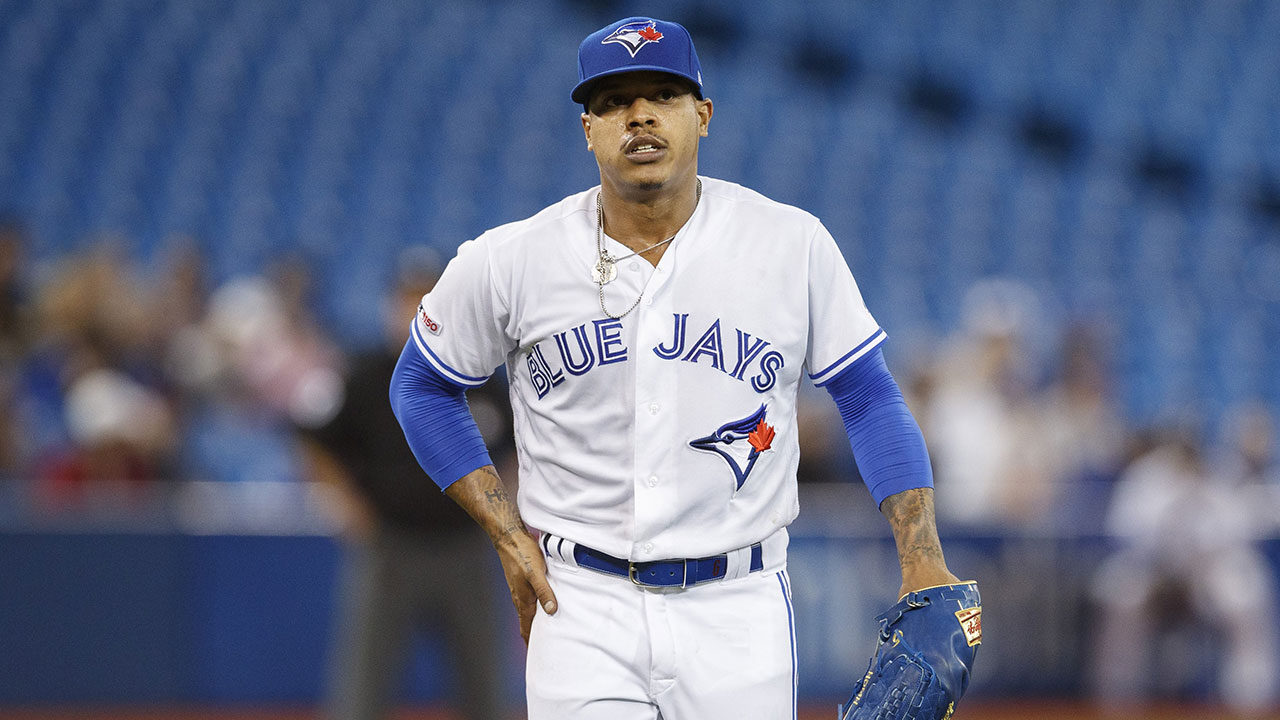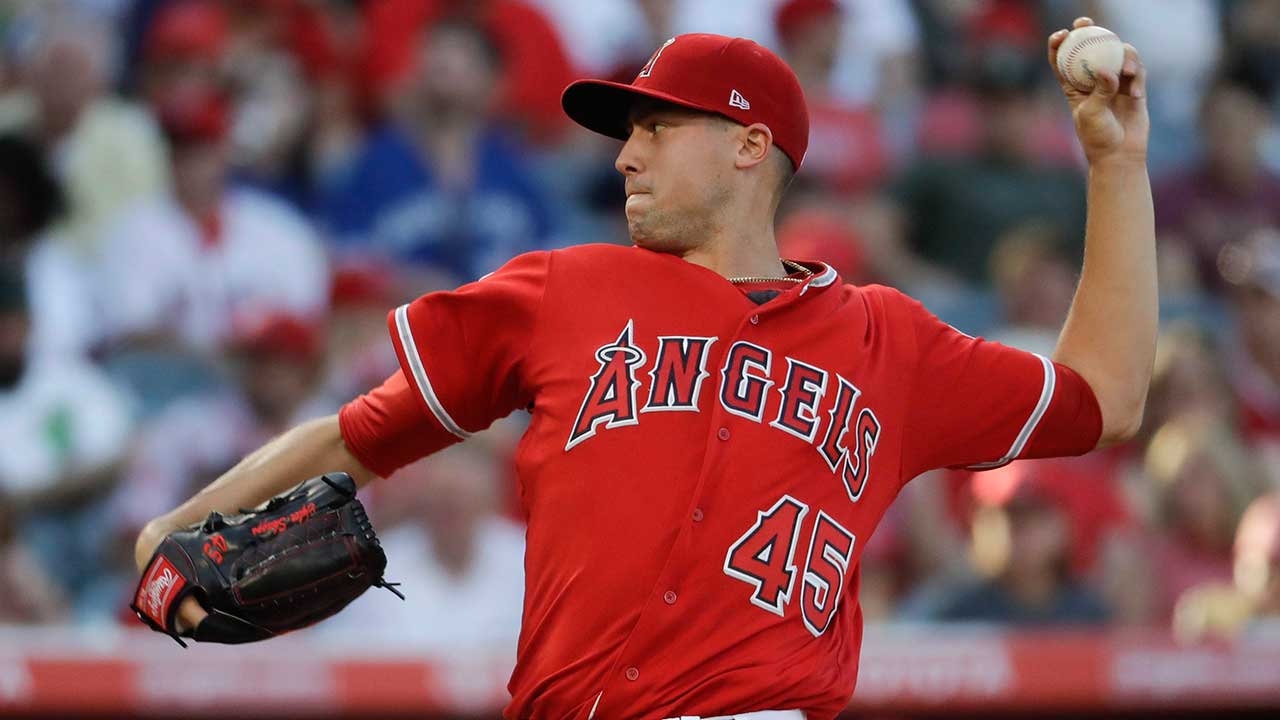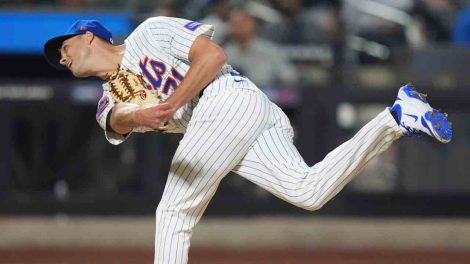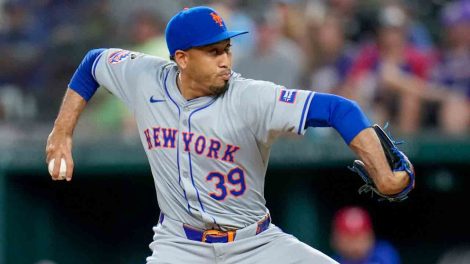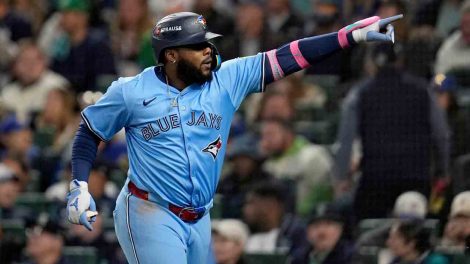Each week Blue Jays Confidential will ask a panel of Sportsnet Blue Jays Insiders and personalities to weigh in on issues big and small with the team, and around Major League Baseball.
1. What event/quote/piece of news from all-star week caught your eye the most?
Jeff Blair (@SNJeffBlair):
Tough to argue against Vladdy, Jr. You’ll have to look elsewhere to find somebody spoiling the narrative.
Arden Zwelling (@ArdenZwelling):
It was Wednesday night’s Atlantic League All-Star Game in York, Pa. where Trackman technology was used to rule balls and strikes. The Atlantic League is experimenting with a bunch of modernizations this season that we could see in MLB someday — banning mount visits, bigger bases, a three-batter minimum for pitchers. And in the second half of the season they’ll be implementing a rule that allows batters to steal first on wild pitches and passed balls. Not sure where I land on that one just yet. But an electronically ruled strike zone is long overdue.
Shi Davidi (@ShiDavidi):
The most pivotal stuff from all-star week always comes from what the commissioner and MLBPA head say during their availability with the BBWAA, and this comment from Rob Manfred about the Rays plan to split time between Tampa Bay and Montreal was super intriguing: “To address what has been an ongoing issue, I think the owners are prepared to live with the idea that they’d operate in two markets. It needs to get resolved somehow. If it means we give up a potential expansion site to solidify where we are, so be it.”
That he describes the Montreal market in such a fashion positions it as a major concession, which theoretically elevates its status against other markets. Also, it seems to confirm that one way or another, the resolution of the Rays’situation runs through Montreal.
Ben Nicholson-Smith (@bnicholsonsmith):
Vladimir Guerrero Jr.’s display of power in the Home Run Derby was something special. You don’t get that kind of performance every year, and this one came from the derby’s youngest ever contestant. Here in Toronto we’ve known about Vlad Jr. for a while. After Monday, all sports fans should have him on their radar.
Mike Wilner (@Wilnerness590):
Vladdy, Jr. He may not have taken the trophy home Monday night at the Home Run Derby, but it was completely his night. I was on a highway in western Pennsylvania, taking my 14 year-old daughter on an all-star break road trip, and the two of us listened to Guerrero’s rounds on the radio. My teenage girl who has only a passing interest in baseball was riveted – nervous, excited, anxious. It was amazing. That second round against Joc Pederson alone could have been the entire derby and it would have been the best ever.
2. Do the Blue Jays need to acquire MLB or close-to-ready MLB pitching in any pre-July 31 dealings, or should they simply look for the best talent available and then try to package other players currently in the organization for help on the mound, either now or the off-season?
Jeff Blair (@SNJeffBlair):
Best talent – including a middle of the order hitter.
Arden Zwelling (@ArdenZwelling):
You always take the best talent available, whether in trade, the amateur draft, on the international market, etc. I do think that if the Blue Jays had two options that they felt similarly about in terms of future value, one a hitter and one a pitcher, they would go with the latter. But they should never take a lesser package in terms of value merely to fill a positional need.
Shi Davidi (@ShiDavidi):
Provided there isn’t a major disparity between the options, yes, absolutely, they must prioritize some near-term big-league pitching. Dealing away Marcus Stroman and Ken Giles without getting some arms back would be a major failure, because ultimately you need a pool of arms for a successful or pitcher or two to emerge. Why? Think of what the Blue Jays gave up for David Price: Daniel Norris, the prime prospect at the time, Jairo Labourt and Matt Boyd, whom the Blue Jays were least worried about. As it turned out, Boyd has been by far the best player Alex Anthopoulos surrendered that summer, underlining why volume matters when developing from within. The Blue Jays lack volume on the arm side. They have to fix that.
Ben Nicholson-Smith (@bnicholsonsmith):
Personally, I think you limit yourself if you only look at pitching that’s close to the major-leagues. What if there’s a better prospect at double-A, but he’s a shortstop? Or a higher-ceiling pitcher at low-A? I’d rather have those guys. Of course all things being equal, the Jays need pitching. I just don’t think we’re at the point of adding finishing touches yet. Until then, find the most value possible, regardless of position.
Mike Wilner (@Wilnerness590):
It’s a dangerous game to make a trade for something you don’t really need with a plan to spin that thing off into something that you do really need down the road. J.P. Ricciardi did it, turning Shannon Stewart into Bobby Kielty into Ted Lilly in a span of four months in 2003, but it’s not something that happens very often. However, it’s better to take an “A” level return that doesn’t involve a pitcher than a “C” level return that does, just because you need pitching. A general manager can tie his hands by saying he’ll only accept a certain position in return in a deal. Very clearly, the Blue Jays need close-to-ready, high-level pitching talent, but they shouldn’t simply go out looking for the best pitcher they can get, if he’s not nearly as good as a position player they could acquire for the same price.
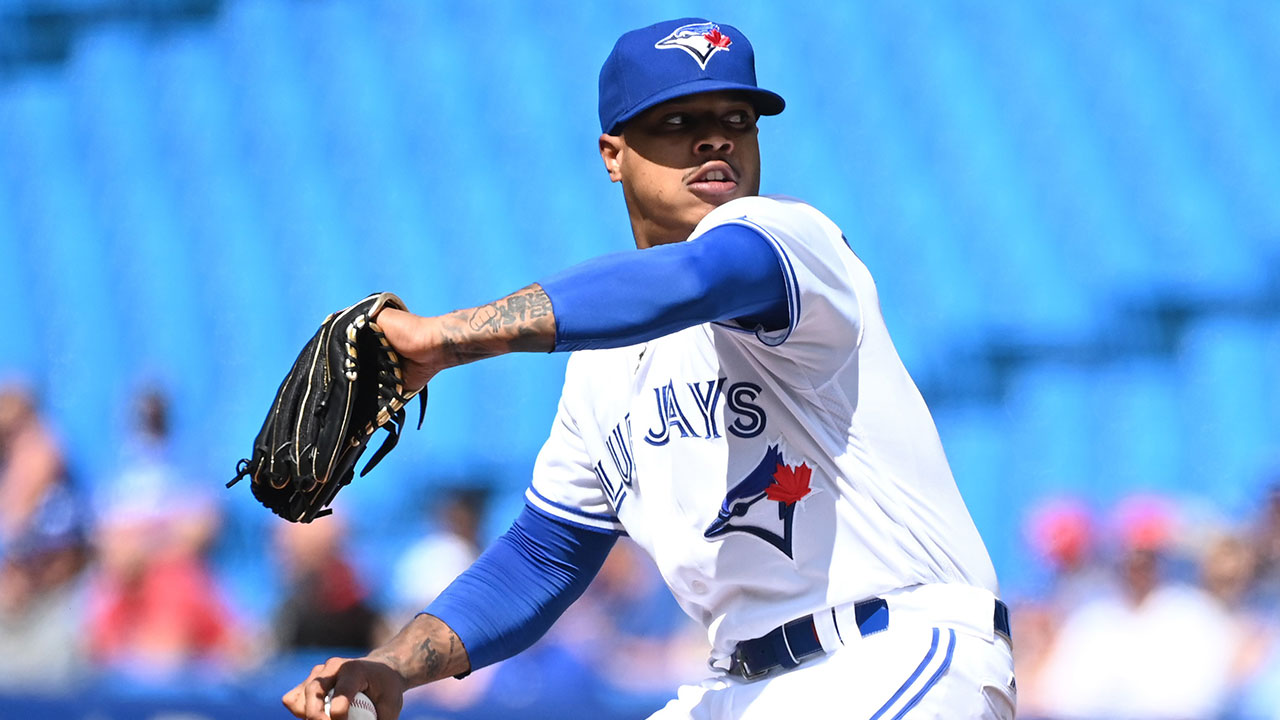
3. Do you buy into the juiced-ball theory and/or do you believe something needs to be done to reduce the amount of balls leaving the yard?
Jeff Blair (@SNJeffBlair):
I believe the ball is being made differently but probably not intentionally so. I’d be scared of over-correcting. Unintended consequences are often worse than the problem that was being corrected.
Arden Zwelling (@ArdenZwelling):
There is absolutely no evidence the ball has been altered in any way — other than home run records being obliterated, average fly ball distance increasing nearly 10 feet since 2015, the more than 30 players who hit 20 homers by the all-star break this season (in 2015 there were 12), and the countless pitchers, hitters, and coaches who have been telling anyone who will listen that the ball is different. Nothing to see here! Should something be done? What can be done? MLB isn’t going to do anything to decrease offence. Everyone but a pitcher likes homers. Just enjoy the fireworks.
Shi Davidi (@ShiDavidi):
Look, there’s some science to the juiced ball so it’s not mere theory, although the degree to which it’s responsible for the home run surge isn’t clear. Bigger picture, kudos to Bob Nightengale for re-opening a talking point many people are all too happy to see disappear, the possibility that PEDs have found their way back into the game. The truth is, we don’t know exactly what’s going on and what’s behind the spike in homers. Given the game’s history, we know that every avenue must be explored. Is that ultimately the X-Factor here and the topic in need of being addressed?
Ben Nicholson-Smith (@bnicholsonsmith):
Major-league baseball needs to find and share some more precise answers here. Otherwise players and fans will still be wondering why the ball changed. I don’t think this is a conspiracy to increase offence, but I do think players and fans deserve to know what has happened to the baseball.
Mike Wilner (@Wilnerness590):
Let’s say Calgary’s Mike Soroka, the Atlanta All-Star pitcher who is allowing the same 0.4 homers per nine innings that he gave up last season, is the exception who proves the rule. The ball is very clearly juiced, though MLB insists it’s unintentional. I question whether deadening the ball would result in more fun, active baseball or just turn some of the home runs we’re seeing now into fly ball outs. If baseball wants more action, hitters need to learn their way around the shift. Of course, the fact that arbitration awards incentivize home runs doesn’t help with that.
[snippet id=4545751]
4. Nate Pearson really turned some heads Sunday in the MLB Futures Game. If he continues to dominate Double-A (0.964 WHIP, 10.3 K/9 ), is he on a path to make a September start or few for the Blue Jays before year-end? Perhaps even sooner?
Jeff Blair (@SNJeffBlair):
Nope. Needs innings in the minors and a regular off-season. No more stress.
Arden Zwelling (@ArdenZwelling):
I think the Blue Jays are going to be pretty careful with his workload over the next few months. He threw only 42 innings combined over 2017 and 2018. And he’s already up to 49 this season. I bet he finishes the year at Triple-A, gets a big-league camp invite next spring, and competes for a spot in the opening day rotation.
Shi Davidi (@ShiDavidi):
I asked about this just before the break and while it wasn’t ruled out, it sure wasn’t talked up. For now, the sense I have is that the Blue Jays want Pearson to continue starting through the end of the minor-league season to rebuild his physical base after losing virtually all of last year to injury. I could see some value in letting him get some innings out of the bullpen before season’s end, but that notion got shot down when I brought up.
Ben Nicholson-Smith (@bnicholsonsmith):
To this point, we’ve seen professional hitters struggle to hit Pearson’s stuff at every level. Clearly, his pitches have a chance to be dominant. If he advances to triple-A and continues to thrive there, you could make the case that he needs to finish his development in the major-leagues, where the lights are brighter and the pressure to execute those plus pitches increases. For that reason, I think a 2019 call-up is possible.
Mike Wilner (@Wilnerness590):
Maybe? But probably not. I think we’ll see him in Buffalo in August, and from there anything is possible, but he’s already thrown more than twice as many innings as he did last year (Arizona Fall League included) after throwing only 20 professional innings in 2017. It’s hard to imagine the Blue Jays wanting him to pitch into September, but you never know. I’d love to see it.
MPH with movement? @big_nate5 domiNATEd the #FuturesGame! pic.twitter.com/SLf6tlPP7U
— Toronto Blue Jays (@BlueJays) 8 July 2019
5.The Blue Jays should consider 2019 a success if ____ occurs between now and the end of the season.
Jeff Blair (@SNJeffBlair):
They don’t lose 100 games, Vladdy stays healthy and Bo and Cavan are playing every day.
Arden Zwelling (@ArdenZwelling):
The Blue Jays are 23 games under.500 and on pace to lose 100 times, so the major-league season can in no way be described as a success. You play the games to win. And in that regard, the Blue Jays have failed. But if Lourdes Gurriel Jr. continues to perform like an all-star as pitchers adjust to him, Vladimir Guerrero Jr. better assimilates to major-league life and begins playing closer to his potential, Bo Bichette reaches the majors and thrives, Cavan Biggio keeps doing what he’s doing, Danny Jansen’s bat comes around, some off-the-board organizational prospects make unexpected leaps, and high-upside, impactful young players (preferably pitchers) are acquired in exchange for Marcus Stroman and Ken Giles, the Blue Jays will have plenty of positives to carry into the off-season.
Shi Davidi (@ShiDavidi):
… Bo Bichette joins the kids in the lineup and they roll through the end of September and they start figuring out the makings of the 2020 rotation …
Ben Nicholson-Smith (@bnicholsonsmith):
If they see continued development from their emerging core of position players while trading Marcus Stroman and Ken Giles for controllable impact players.
Mike Wilner (@Wilnerness590):
If they find that they have legitimate core pieces in Danny Jansen and Lourdes Gurriel, Jr. to go with Guerrero, Biggio and Bichette, and if (having apparently decided that extensions aren’t happening) they can turn Marcus Stroman and Ken Giles into a group of assets that will help lead them to not have to look for another Stroman and Giles a couple of years down the road when they’re ready to contend. In that case, it’s a success in the build towards future contention. There’s no way to spin this season as a success on the field.
